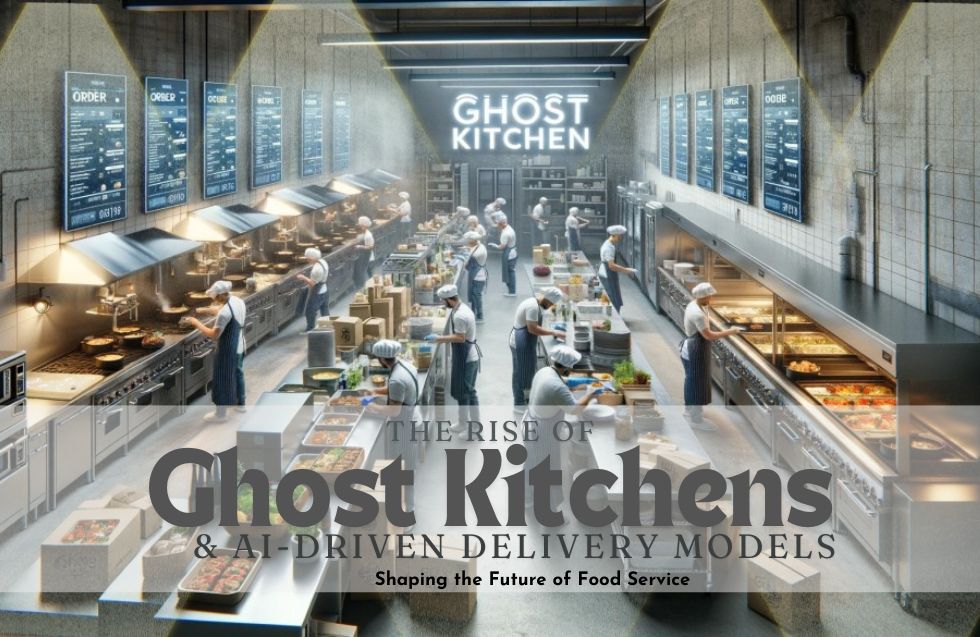In recent years, the food service industry has experienced a rapid transformation due to shifting consumer preferences and technological advancements. Among the most groundbreaking innovations are ghost kitchens—virtual kitchens designed solely for delivery—and AI-driven delivery apps that use artificial intelligence to optimize the logistics of food delivery. Together, these models are not only redefining the restaurant business but also creating a new ecosystem where food preparation and delivery are more efficient, scalable, and profitable.
What Are Ghost Kitchens?
Ghost kitchens, also known as cloud kitchens, dark kitchens, or virtual kitchens, are commercial facilities designed for the sole purpose of preparing food for delivery. Unlike traditional restaurants, ghost kitchens have no dine-in area or waitstaff. Instead, they rely entirely on online orders placed through delivery platforms like Uber Eats, DoorDash, or proprietary mobile apps.
This model allows businesses to significantly reduce operational costs:
- Lower Real Estate Costs: Ghost kitchens can be located in less expensive areas since they don’t rely on foot traffic. In fact, real estate savings can amount to as much as 50% compared to traditional restaurant spaces.
- Flexible Menus: Virtual kitchens allow brands to experiment with multiple concepts from a single kitchen. A chef could operate a pizza brand, a sushi brand, and a burger brand all from the same kitchen, maximizing the use of resources.
- Efficient Staffing: Without the need for front-of-house staff like servers or hosts, ghost kitchens require fewer employees. This reduces labor costs by approximately 30% to 40% compared to traditional dining establishments.
Ghost Kitchens by the Numbers
The rise of ghost kitchens has been driven largely by the boom in food delivery services. According to a 2023 report by Statista, the global online food delivery market is expected to grow to $1.45 trillion by 2027, up from $339 billion in 2022. Ghost kitchens are playing a central role in meeting this demand, particularly in densely populated urban areas where space is at a premium and consumers prioritize convenience.
Some additional key statistics that illustrate the growth of ghost kitchens:
- In 2020, Euromonitor International predicted that ghost kitchens could become a $1 trillion global industry by 2030.
- The U.S. ghost kitchen market alone was valued at $43.1 billion in 2022 and is projected to grow at a 12.4% CAGR (Compound Annual Growth Rate) through 2028.
- In China, where food delivery services are a staple in urban life, the ghost kitchen market has already reached $400 billion.
AI-Driven Delivery Models: Optimizing the Last Mile
The rise of ghost kitchens has been closely tied to advances in food delivery technology, particularly AI-driven delivery apps. These platforms use artificial intelligence to manage the logistics of delivering food, from order placement to customer delivery. By leveraging AI, delivery platforms can streamline operations, reduce costs, and improve the customer experience.
Key Benefits of AI-Driven Delivery Apps:
- Route Optimization: AI algorithms analyze real-time data on traffic patterns, weather conditions, and road closures to create the most efficient delivery routes. This reduces delivery times and fuel costs. According to McKinsey, AI-enabled logistics can decrease delivery costs by up to 40%.
- Demand Forecasting: AI systems can predict peak ordering times by analyzing historical order data, local events, and even social media trends. This allows ghost kitchens to prepare in advance, reducing wait times and preventing food waste. For example, Domino’s uses AI-powered predictive ordering to manage high-demand periods, cutting average delivery times by 20%.
- Customer Personalization: AI can track customer preferences and purchase history to offer personalized food recommendations and promotions. This not only improves the user experience but also increases customer retention and average order value. According to Accenture, businesses that use AI for personalization can see a 20-30% increase in sales.
- Autonomous Delivery: AI-driven apps are laying the groundwork for autonomous food delivery. Companies like Nuro and Starship Technologies are testing self-driving delivery vehicles, reducing the need for human drivers. In 2022, Nuro began partnering with major brands like Walmart to pilot autonomous grocery delivery, and these innovations are expected to reduce last-mile delivery costs by 30-40% over time.
Countries Ready for Ghost Kitchens
While ghost kitchens are popping up around the world, certain countries have proven to be ideal markets due to their growing urban populations, tech-savvy consumers, and the increasing demand for food delivery services.
- United States: The U.S. is leading the ghost kitchen revolution, with thousands of virtual kitchens operating across major cities. Companies like Kitchen United and CloudKitchens are rapidly expanding, offering turnkey solutions for restaurants to enter the ghost kitchen space. In 2021, Grubhub reported that food delivery accounted for 53% of all restaurant sales in the U.S., up from 37% in 2019.
- China: China is the largest food delivery market in the world, with platforms like Meituan and Ele. me delivering millions of meals daily. Ghost kitchens are increasingly common in cities like Beijing and Shanghai, where fast food delivery is a way of life. By 2023, food delivery accounted for 15% of total food service sales in China, according to research.
- India: India’s food delivery market is expected to reach $21.41 billion by 2026. With a young, tech-savvy population, the country has seen a surge in demand for ghost kitchens. Companies like Rebel Foods are leading the charge, operating multiple virtual brands from a single kitchen, including popular brands like Faasos and Behrouz Biryani.
- United Kingdom: In the UK, ghost kitchens are expanding rapidly, with companies like Deliveroo Editions offering kitchen spaces for restaurant partners to operate delivery-only services. A 2021 report by Mintel found that one in three British consumers ordered food delivery at least once a week, a trend that has spurred the growth of ghost kitchens across cities like London, Manchester, and Birmingham.
- Middle East: The Middle East, particularly the UAE and Saudi Arabia, has seen significant growth in ghost kitchens due to its high adoption of food delivery services. Dubai is home to several ghost kitchen brands, and food delivery accounted for over 70% of restaurant sales in the city during the pandemic, according to Knight Frank.
The Future of Food: What’s Next for Ghost Kitchens and AI Delivery?
The future of ghost kitchens and AI delivery is full of possibilities. The combination of these two models is expected to further disrupt the food service industry in the following ways:
- Hyper-Localized Menus: As AI collects more data, ghost kitchens will be able to offer hyper-localized menus tailored to the tastes of specific neighborhoods or cities.
- Increased Automation: From autonomous delivery vehicles to robotic kitchen assistants, AI will continue to streamline operations, reducing the need for human labor and cutting costs.
- Sustainability: AI can help optimize energy use in kitchens and delivery, contributing to more sustainable business practices.
Conclusion
The rise of ghost kitchens and AI-driven delivery apps is reshaping the food service industry in profound ways. These innovative models allow businesses to reduce costs, scale efficiently, and cater to the growing demand for fast, convenient, and personalized food delivery. With countries like the U.S., China, India, and the UK leading the charge, and AI technology advancing rapidly, the future of food service is digital, on-demand, and highly optimized for both businesses and consumers alike.
The global trend suggests that both ghost kitchens and AI-powered delivery platforms are here to stay, and those who embrace this new frontier will be well-positioned for long-term success in the evolving food industry.













